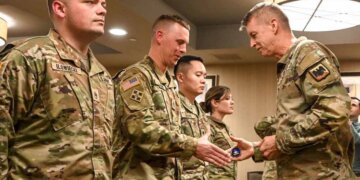by Andrea Downing Peck
A recent landmark Supreme Court decision clarifies property rights in military divorce settlements, but the ruling means spouses of military retirees with service-related disabilities may receive reduced shares of pension payments in divorce cases.
Mark Sullivan, a retired Army Reserve JAG colonel, who practices family law in Raleigh, N.C., calls the ruling “the death of indemnification,” which is the ability of a court to increase a former spouse’s share of military retirement pay to make up for a loss in benefits if the service member elects to receive offsetting VA disability pay.
The Case
The Supreme Court case involved an Air Force couple who divorced in 1991. With John Howell’s retirement a year away, the couple’s divorce decree specified Sandra Howell would receive 50% of his military retirement pay. In 2005, Sandra went back to court after John gave up $250 of his $1,500 in retirement pay so he could receive that amount in tax-free disability benefits. An Arizona family court agreed Sandra Howell should still receive an amount equal to half of what John’s retirement pay would have been without the disability benefits. John Howell appealed that decision up to the Arizona Supreme Court, which also sided with Sandra Howell, noting federal law did not pre-empt the family court’s order.
In May, the U.S. Supreme Court unanimously overturned the Arizona Supreme Court decision. “State courts cannot ‘vest’ that which (under governing federal law) they lack the authority to give… Accordingly, while the divorce decree might be said to ‘vest’ [the former spouse] with an immediate right to half of military retirement pay, that interest is, at most, contingent, depending for its amount on a subsequent condition: [the servicemember’s] possible waiver of that pay,” Justice Stephen Breyer wrote in Howell v. Howell. Breyer also cited the high court’s 1989 decision in Mansell v. Mansell, which held that federal law prohibited California from treating the waived portion of military retirement pay as community property divisible at divorce.
“We now have a clear understanding that even if it is after the divorce, a judge’s hands are tied regarding enforcement of reimbursement or compensation to the former spouse for any amount the servicemember chooses to waive because of a VA disability rating,” said Sullivan, who is author of The Military Divorce Handbook. “He can waive it, and when that happens she’s stuck. There’s no other way to put it.”
Praise for the Ruling
The Veterans of Foreign Wars (VFW) praised the Supreme Court for “providing some much-needed consistency” in how the 1982 Uniformed Service Members Former Spouse Protection Act (USFSPA) is applied to divorce settlements nationwide.
“USFSPA preempts a state court ruling, but what we had been seeing, and know exists, were various interpretations at the state level of applying the USFSPA,” said VFW Assistant Quartermaster General John Muckelbauer, pointing out that Arizona was not alone in requiring military retirees to make up for a spouse’s lost retirement income due to a VA waiver. “What we wanted more than anything was a consistent approach.”
While USFSPA does not automatically entitle a former spouse to a portion of a service member’s retired pay, it does recognize the right of state courts to distribute military retired pay to a former spouse in a divorce decree. The socalled “10/10” rule, which is also part of USFSPA, requires the Defense Finance and Accounting Service to make direct payments of the divided retired pay to a former spouse if the parties were married at least 10 and the marriage overlapped at least 10 years of the service member’s credible military service time.
Matthew Randle, an Arizona lawyer who specializes in military family law, was not surprised by the Supreme Court ruling, which he points out did not hinge on the “fairness” of the monetary loss suffered by Sandra Howell when her ex-husband choose to waive a portion of his military retirement pay.
“At the state level, we saw a series of decisions that tried to do what was equitable or fair, but that so flew in the face of the state law – Arizona has a specific state law that says military disability benefits are non-divisible. Unfortunately for Mrs. Howell, the reality of her situation had nothing to do with where the ruling came down,” Randle stated, adding the decision likely will be extended to divorce settlements involving federal employee disability pay and Social Security Disability Income as well.
Concerns About the Ruling
Some military spouse organizations fear the Supreme Court ruling will result in many ex-spouses receiving reduced shares of military pensions since retirees have an incentive to waive military retirement pay in favor of tax-free disability benefits. Currently, only retirees with at least a 50% VA disability rating receive both their full military retirement pay and VA disability compensation concurrently.
Lisa Colella, president and CEO of Healing Household 6, a nonprofit program that assists caregivers of wounded warriors, foresees financial repercussions for ex-spouses, particularly those who may have been in abusive marriages, served as permanent caregivers or were unable to build retirement savings of their own. While she supports VA disability pay being earmarked for the military member, Colella argues divorce courts should have latitude to consider a servicemember’s waived retirement benefits when dividing marital assets under USFPA.
“You will have all these specialty cases now where there is no way to determine them case by case,” says Colella, whose husband was medically retired from the Marine Corps due to injuries sustained in Iraq. “I think that is an unfair assessment for those families. Those families weren’t thought of when this ruling was made.”
Future Implications
Allison Beard Wall, whose husband is due to retire from the Navy this year, believes the “real issue” is not the Supreme Court ruling, but the fact not all retirees are eligible for concurrent receipt of disability and retirement pays.
“Retirement is future payment of income the spouse helped earn previously – it’s delayed compensation. VA disability is to help offset future income losses the veteran might have to absorb due to disability,” she says. “It’s about income not earned yet and the spouse not being around for it if they’re divorced.”
“It’s not the service member’s fault Congress has decided those with less than 50% disability cannot collect VA disability concurrent and that one offsets the other,” Wall adds.
The Military Officers Association of America (MOAA) agrees. MOAA is using the Supreme Court ruling as a spring board to lobby for extending concurrent receipt to all military retirees with a VA disability rating. In a statement, MOAA points out the case “clearly illustrates the unfairness” of reducing DOD retired pay for VA disability compensation.
“MOAA believes a more equitable solution for all parties is to eliminate this offset entirely and to allow for concurrent receipt,” MOAA says.
In delivering the ruling, Justice Breyer noted a family court judge when determining the value of a family’s assets “remains free to take account of the contingency that some military retirement pay may be waived” by the service member.
However, Sullivan believes Breyer’s acknowledgment of the potential negative ramifications of the ruling does nothing to remedy the problems it creates.
“Look at the Howell case. You tell me how the judge in year one – the year of the divorce – would ever know John Howell 14 years later would apply for and get a 20-percent disability rating from the VA worth $250 that would cost Sandra Howell $125,” Sullivan says.
Read comments





































